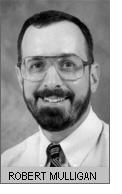|
|
 AUTHOR
EXPLAINS BUSINESS CYCLE IN DEPTH AUTHOR
EXPLAINS BUSINESS CYCLE IN DEPTH
By Robert
Mulligan
Roger W. Garrison of Auburn presents the Austrian
theory of the business cycle in a lucid and thorough new book that also
compares and contrasts alternative Keynesian and monetarist theories within
a common theoretical framework.
In Time and Money: the Macroeconomics of Capital Structure, he makes
extensive use of the Hayekian triangle introduced by Nobel laureate Friedrich
A. Hayek in his Prices and Production in 1931.
Production takes time, and Hayek illustrated the production process as
a right triangle with the base as production time, the height as the output
delivered to consumers, and the slope of the hypotenuse proportional to
the interest rate.
For illustrative purposes, Garrison divides the base of the triangle into
five hypothetical stages of production: mining, refining, manufacturing,
wholesale and retail.
Mining is at the point of the triangle, most remote from the final consumer,
who buys the final consumption goods from a retailer. Value is added at
each stage of production, adding to the value of final output delivered
to the consumer through retail.
The main problem (Memo to Alan Greenspan!) comes when the government or
the Federal Reserve artificially lower the interest rate below the sustainable
natural rate. The money supply is increased without raising consumer desire
to save or lowering their desire to consume.
Saving and consumption stay the same, but investment increases by the increase
in the money supply. Because the interest rate goes down, new investment
is concentrated in earlier stages of production, but consumers continue
to buy the same amount as before, so the height of the triangle remains
unchanged.
Something has to give, and the triangle becomes pinched in the middle,
and eventually the economy has so many resources allocated to earlier stages
of production it can no longer supply the same high output desired by consumers,
resulting in recession and unemployment.
Firms lay off workers because the equipment they were hired to operate
yields too low a return. The low yield was fine at the artificially low
interest rate, but once the injection of new money ends, the interest rate
returns to its sustainable market level, and production has to yield a
better return to stay competitive.
One cause of the persistence of recessions, six months to two years, is
the fact that installed capital cannot be reallocated very quickly.
The greatest virtue of this book is its clear explanation of the business
cycle, something that should appeal to all interested readers.
In addition, Garrison also presents alternative Keynesian, monetarist,
and new classical theories of the business cycle in the same framework.
This allows the reader to understand how the different schools of economic
thought relate to each other, and compare their theories of the business
cycle. It also ensures the book a wide academic audience outside the Austrian
school.
Its first printing has already sold out, something very unusual for an
academic book, and hopefully a less pricey paperback edition will be available
soon.
Robert F. Mulligan is assistant
professor of economics in the business computer information systems and
economics department in the College of Business at Western Carolina University.
For previously reviewed books, visit Web site at www.wcu.edu/cob/bookreviews
|


 AUTHOR
EXPLAINS BUSINESS CYCLE IN DEPTH
AUTHOR
EXPLAINS BUSINESS CYCLE IN DEPTH